From Plastic Trash to Art
Air Date: Week of June 27, 2025
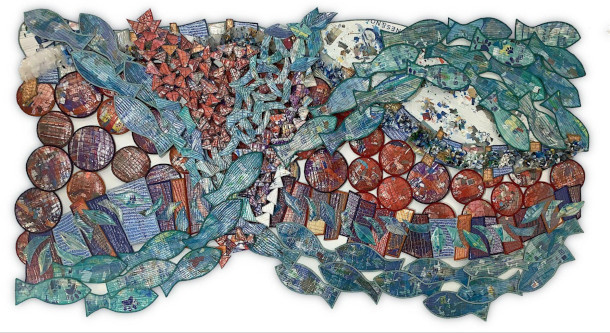
Erik Jon Olson makes decorative quilts out of single use plastic. Now Streaming, 2025, quilted plastic waste, 45"x85". (Photo: Courtesy of Erik Jon Olson)
The ugly truth of plastic is that the world produces over 400 million metric tons each year and recycles less than ten percent of it. But artist Erik Jon Olson is transforming unsightly plastic waste into beautiful, quilted works of art which are popping up in galleries and exhibitions across the United States. He joins Host Jenni Doering to share the meaning and method behind his whimsical and striking artwork.
Transcript
CURWOOD: It’s Living on Earth, I’m Steve Curwood.
DOERING: And I’m Jenni Doering.
Over 400 million metric tons of plastic are produced worldwide each year, leaving a huge carbon footprint and a waste problem that never seems to go away. Less than ten percent ends up recycled, leaving much of the rest to pollute our planet’s oceans, rivers, lakes, and land and break down into microplastics that are found nearly everywhere, from Mount Everest to the depths of the Mariana Trench, to our own bodies. But art can elevate plastic from trash to treasure. Minnesota artist Erik Jon Olson is transforming polymers into works of art which are popping up in galleries and exhibitions across the United States. And he joins me now. Welcome to Living on Earth, Erik!
OLSON: Thank you.
DOERING: So I have to say, I was kind of floored by how beautiful your artworks are, and yet they're made of plastic. So can you please describe this metamorphosis and paint a picture for us of your art?
OLSON: Well, my art is quilted plastic waste. It is used plastic like what you would get frozen vegetables in, that kind of packaging. There's about 8 to 12 layers of plastic to get it to be thick and pillowed like an actual quilt would be. So it's a lot more layers than a quilt is. And I'll pin it in place, and then just start running it through the sewing machine, and then I will cut the shapes out of that quilted piece, bind the edges, and then I will sew those pieces together.
DOERING: Wow, not your grandmother's sewing project,
OLSON: No, but it is my grandmother's sewing machine.
DOERING: Oh, I love that.
OLSON: I do too.
DOERING: So what does it look like? What would somebody first notice, do you think, if they walked into an art gallery and saw one of your pieces?
OLSON: They would probably notice the bright color. That would be the first thing they notice. The color is from the plastic. I don't add any color to it. They would notice that they are very playful and that they're very whimsical looking. They would notice that they have a strong graphic design quality to them. That is my creative background from advertising industry in graphics and graphic design, so that has a strong influence on what the designs look like. They'd also notice that they are rather large, like five by seven. So that's 35 square feet.
DOERING: Could you describe a favorite piece of yours? I know it's hard to choose, but if you had to.
OLSON: If I had to, it's called "Now Streaming." It's like a school of fish swimming in a pattern that is like an infinity symbol, and behind that stream of fish is like a hugely magnified blood vessel with big red circles in it. And then over the front of it is kind of like a net. And then in the background, that "S" curve of the blood vessel, when that shape is interacting with the infinity symbol shape, it looks like a double helix.
DOERING: Whoa, so like our DNA?
OLSON: Yeah. So what it is representing is plastic going into the oceans, breaking down into the microplastics that the fish eat. We eat the fish. The microplastics become nanoplastics and end up in our bloodstream. And pretty soon, if it hasn't already, it's going to end up in our DNA.
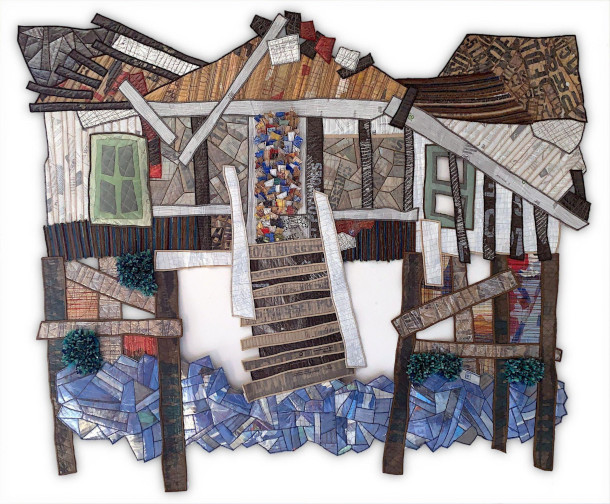
Pictured above is Surged, 2024, quilted plastic waste, 55"x68". (Photo: Courtesy of Erik Jon Olson)
DOERING: Yeah, they end up in our bloodstream, and they seem to be wreaking a lot of havoc in our bodies.
OLSON: Yes.
DOERING: Yeah, I mean, I really appreciate how accessible some of your artwork is. Like, you know, this green one that you have that's made of recycling motifs. It has the numbers one through seven, all jumbled up. That's one through seven for the types of plastic. And I mean, I love the irony of that, since this is made of plastic, and the fact that you're like, really getting the message across about this like morass that is recycling symbols.
OLSON: Yes, and the title of that piece is, "Not So Green As You Think."
DOERING: Ah.
OLSON: And that's my statement on how deceptive that recycling campaign really is.
DOERING: Yes. It makes us think, oh, wonderful, this is recycled.
OLSON: You think they're all getting recycled because they all have the chasing arrow. So they're all getting recycled. It's like, no.
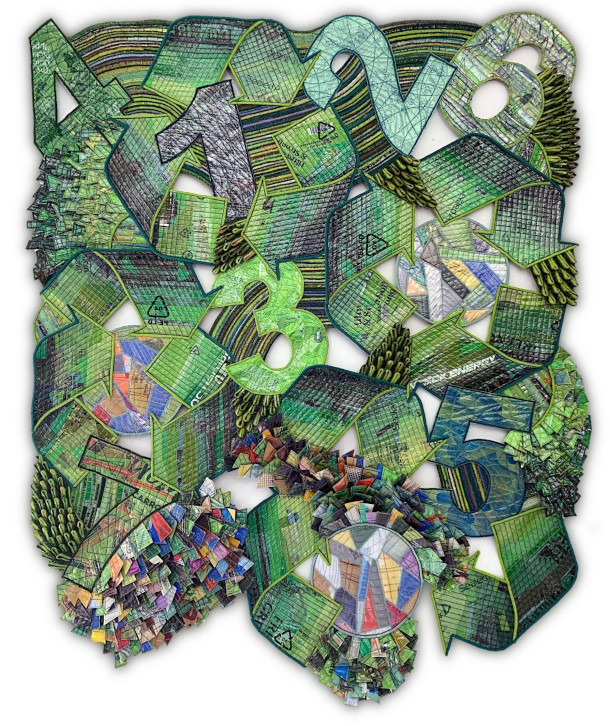
Not So Green as You Think, 2024, quilted plastic waste, 50"x42". (Photo: Courtesy of Erik Jon Olson)
DOERING: Tell me a little bit about how you became an artist. What drew you to this medium?
OLSON: Oh, around 2005 I left the advertising industry. One day I came home and I said to my wife, I just can't do this one more day. I just can't do it. At the same time that I was going through that, a very good friend of mine had become really concerned about the amount of single use plastic in the waste stream, and he figured out that you could layer it up and run it through a sewing machine. So he started a small cottage industry company that made functional items out of that sewn up plastic, like computer covers or tote bags. And knowing my advertising background, he conscripted me to do the branding of that company. But any manufacturing has waste. That process had waste too. He knew that I liked to make things out of whatever stuff was lying around. I've done that my whole life. So he convinced me to take the scraps of that process home to see what I could do with it. And then that's how I started working in this medium.
DOERING: What was it like to play around with this plastic when your friend sent you home with some, and what was it like when you made the first thing?
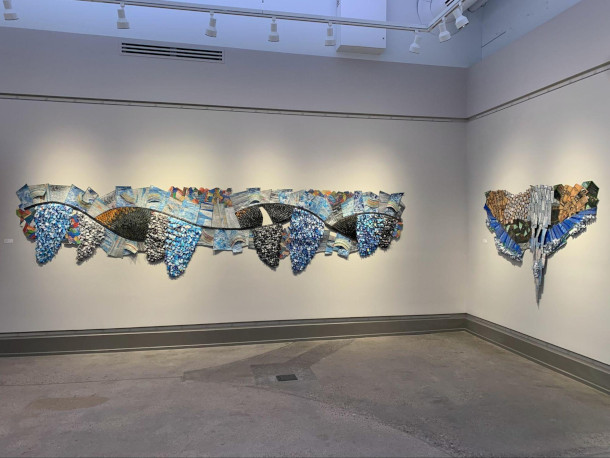
Erik’s quilted pieces can be quite large, spanning as much as 35 square feet. Exhibit installation, Post-Consumer, August – October 2023. (Photo: Courtesy of Erik Jon Olson)
OLSON: Oh, it was a long learning curve. So there was a lot of experimenting, and it took about three years before it popped into my head that maybe I should be adding some content to these pieces, and maybe the content should be about plastic, since I'm using plastic waste as the medium. If the content also was about the consequences of that plastic waste, then I would really punch home, I guess, that the actual medium becomes the message.
DOERING: How have you been influenced by other artists? And you know, who are you inspired by?
OLSON: An artist that influenced me from the very beginning, his name is Edward Burtynsky. He's a photographer from Canada. He'll fly a drone over a delta in Southeast Asia where all the junk is just going right into the ocean, or he'll have a drone shot over a strip mine. He's got this cool one that's just piles and piles, the whole thing is filled with used tires. It's just piles and piles of used tires. So it makes this really cool pattern and texture that you don't immediately connect, oh, it's tires. They're stunningly beautiful, and that beauty draws you in, and then after you're hooked in with that beauty, then you're like, slapped in the face with the ghastly message of what it is. So that's what I try to do with my artwork, although I'm relying on, more on playfulness and whimsy than stunning beauty.

California Dreamin', 2024, quilted plastic waste, 54"x54”. (Photo: Courtesy of Erik Jon Olson)
DOERING: Yeah, kind of a twisted beauty, I guess.
OLSON: Yeah, yeah.
DOERING: So Erik, you had a career in advertising before you retired and wound up becoming an artist. To what extent did that background inform the way that you approach your art now?
OLSON: Other than feeling like I have to make amends for trying to get people to buy crap they don't need. Well, a lot is the creative process that I go through is very much like I learned when I was in the advertising industry. So I don't like just sit down and start experimenting and putting stuff together and organically following where that's going. It's very much decided before anything happens, like from the news or from, well, from your program.
DOERING: Oh, really?
OLSON: Ideas start.
DOERING: Wow, we're coming full circle here.
OLSON: Yeah.

Erik says that he now has a zero waste artistic process. He incorporates every scrap he creates back into his pieces. (Photo: Courtesy of Erik Jon Olson)
DOERING: That's amazing.
OLSON: But once I have that visual that goes with the concept, then I start in sewing the plastic together and cutting away and...
DOERING: And by the way, where do you get your materials from? I mean, are you still getting them from your friend?
OLSON: Not anymore. I have now collected enough plastic from my own consumption that that's all I use now, so none of my plastic gets thrown away. I try to invent ways to put it back into my artwork. So over this last year, I was actually able to come to absolute zero material waste.
DOERING: Whoa.
OLSON: Yeah, that's cool.
DOERING: So I'm sure your art is always evolving, and it, you know, it's changed a lot over the last 20 years or so. What's next for you?
OLSON: Well, I'm going to keep going with this. Most of my art has been two dimensional, but with some of the ways I'm using all those little, tiny bits of scrap I'm moving or trying to move into some three-dimensional work, it is a real challenge for me, because my whole life has been spent in two-dimension world.
DOERING: So how are you doing that? Does that involve some paper mache, or, I don't know?
OLSON: No, it involves a lot of using a lot of the scrap as stuffing.
DOERING: Ah, okay.
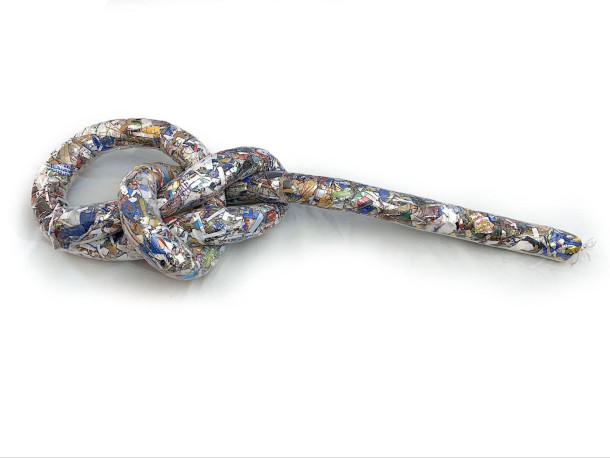
Waste Knot, 2025, the waste from previous works, 42"x13"x7". (Photo: Courtesy of Erik Jon Olson)
OLSON: Like the latest 3D one, I made a clear plastic casing like a rope sausage, maybe three inches in diameter and about 14 feet long. And I had saved up all the clippings, and I stuffed that casing with all those tiny bits and pieces, and you can see them because the casing is clear, sealed the ends and then tied that big long rope sausage into a bow hitch knot, which is the knot that sailors typically use to tie the anchor to their boat. And it's, it is called, "Waste Knot," K-N-O-T.
DOERING: Why did you choose that knot in particular?
OLSON: Oh, because it was typically used as an anchor. And we are weighed down with our, with our plastic. And I was being weighed down because I didn't want to throw all that stuff out. So I was being weighed down by the idea of, how do I use the very last scrap, waste of the waste of the waste of the waste.
DOERING: Yeah. So, Erik, how do you feel about the climate moment right now, this like plastic catastrophe, a lot of these things that you cover in your work? What motivates you to keep on keeping on?
OLSON: Keep on, what motivates me? I do believe my anxiety motivates me a great deal over what's going on. Another thing that motivates me is how rapidly concepts keep coming to me. I can't turn it off.
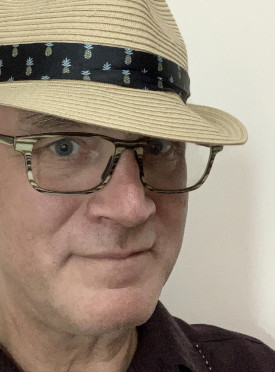
Erik Jon Olson is an artist based in Minnesota. His work has been exhibited across the United States. (Photo: Courtesy of Erik Jon Olson)
DOERING: Wow, it sounds like you're kind of a conduit, receiving these ideas from the universe or something.
OLSON: That’s what it feels like, yeah, yeah.
DOERING: You know, there's all kinds of different ways to grapple with and respond to the climate crisis. I mean, I'm grateful for all the scientists who are trying to understand what's happening, but why do you think we need artists in this moment?
OLSON: I firmly believe that art can change things for the better. I was just listening to and watching a little video that was talking about how in cities that have areas that are not cared for, and the crime rate goes up, and then people start feeling hopeless, and things just get worse and worse. But if the city invests in, say, making that empty lot, if they make it green, paint a big, beautiful mural on the building that's sitting next to it, when those spaces are made into artful spaces, the crime rate goes down. So it does give people hope, I think, and it lifts, it lifts up the human spirit.
DOERING: Erik Jon Olson is an artist based in Minnesota. Thank you so much for joining us. This has really been a pleasure.
OLSON: Absolutely.
DOERING: And you can find pictures of Eric's artwork on the Living on Earth website, loe.org.
Links
Living on Earth wants to hear from you!
Living on Earth
62 Calef Highway, Suite 212
Lee, NH 03861
Telephone: 617-287-4121
E-mail: comments@loe.org
Newsletter [Click here]
Donate to Living on Earth!
Living on Earth is an independent media program and relies entirely on contributions from listeners and institutions supporting public service. Please donate now to preserve an independent environmental voice.
NewsletterLiving on Earth offers a weekly delivery of the show's rundown to your mailbox. Sign up for our newsletter today!
 Sailors For The Sea: Be the change you want to sea.
Sailors For The Sea: Be the change you want to sea.
 The Grantham Foundation for the Protection of the Environment: Committed to protecting and improving the health of the global environment.
The Grantham Foundation for the Protection of the Environment: Committed to protecting and improving the health of the global environment.
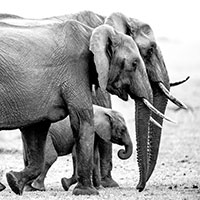 Contribute to Living on Earth and receive, as our gift to you, an archival print of one of Mark Seth Lender's extraordinary wildlife photographs. Follow the link to see Mark's current collection of photographs.
Contribute to Living on Earth and receive, as our gift to you, an archival print of one of Mark Seth Lender's extraordinary wildlife photographs. Follow the link to see Mark's current collection of photographs.
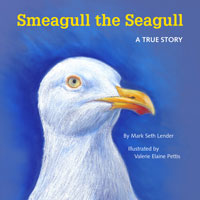 Buy a signed copy of Mark Seth Lender's book Smeagull the Seagull & support Living on Earth
Buy a signed copy of Mark Seth Lender's book Smeagull the Seagull & support Living on Earth

